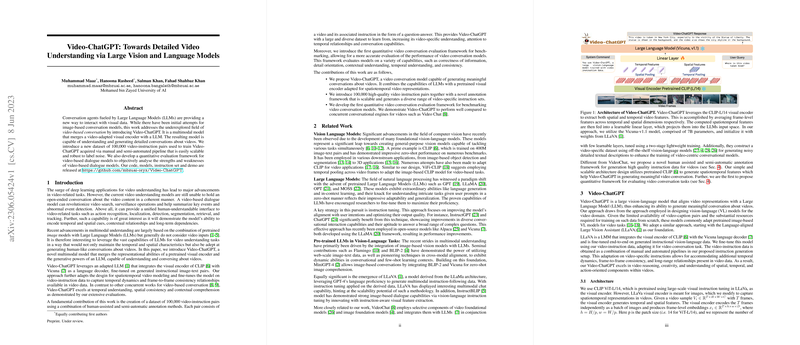An Analysis of Video-ChatGPT: Advances in Video-Based Conversational Agents
The paper "Video-ChatGPT: Towards Detailed Video Understanding via Large Vision and LLMs" presents a significant advancement in the domain of multimodal models, specifically focusing on video-based conversational capabilities. The authors introduce Video-ChatGPT, a model that synergistically merges a video-adapted visual encoder with a LLM, thereby facilitating detailed and coherent conversational interaction with video content.
Model Architecture and Innovation
Video-ChatGPT builds upon the foundational capabilities of LLaVA by integrating a visual encoder from the pretrained CLIP model and a language decoder based on Vicuna, refined on instructional datasets. It leverages a linear adapter to align visual and textual representations and is specifically fine-tuned to enhance spatiotemporal understanding, a critical aspect for effective video dialogues. The process importantly retains the pretrained model's weights while only optimizing the linear layer, ensuring adaptability and efficiency.
Dataset Development
A notable contribution of this work is the creation of a dataset comprising 100,000 video-instruction pairs. This dataset is generated through a meticulous blend of human-assisted and semi-automatic annotation techniques. The data encompass diverse tasks, such as detailed descriptions, summarizations, and creative generation, aimed at enriching the model's conversational repertoire. The human-assisted annotations infuse detailed contextual nuances, while the semi-automatic methods provide scalability without significantly compromising quality.
Evaluation Frameworks
The paper introduces a quantitative evaluation framework, designed to benchmark video conversation models comprehensively. This framework assesses the model across several critical dimensions, such as correctness, detail orientation, contextual insights, temporal understanding, and consistency. The evaluations reveal that Video-ChatGPT demonstrates competent performance relative to existing models like Video Chat, particularly excelling in temporal and contextual comprehension.
Quantitative and Qualitative Performance
In zero-shot question-answer evaluations across multiple datasets (MSRVTT-QA, MSVD-QA, TGIF-QA, and ActivityNet-QA), Video-ChatGPT consistently outperforms its counterparts. Its strong performance underscores the model's adeptness at drawing meaningful insight from video content and generating accurate, contextually relevant responses.
Further, the qualitative assessments display the model's capability in various tasks including video reasoning, spatial understanding, and creative generation. These results emphasize the model's proficiency in handling complex video-based inquiries, reinforcing its utility in practical applications like video surveillance and content summarization.
Implications and Future Directions
The implications of this work are manifold. Practically, the enhanced ability to interact with video content can revolutionize applications in video search, surveillance, and automated content creation. Theoretically, this represents progress in the integration of vision and LLMs, enhancing their applicability in real-world scenarios.
Looking forward, advancements could include extensions to accommodate multiple modalities simultaneously, thereby further broadening the scope and utility of video-based conversational agents. Addressing challenges in finer temporal relationships and enhancements in small object detection are additional areas for future exploration.
In conclusion, Video-ChatGPT represents a substantive step forward in video-based dialogue systems, reflecting significant advancements in multitasking, multimodal comprehension, and conversational interaction. This work sets a promising trajectory for the continued evolution and application of AI in multimedia understanding.
